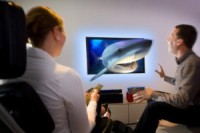 In the second of my articles looking at where telly is headed, I thought I’d tackle one of the biggest innovations around at the moment, 3D entertainment.
In the second of my articles looking at where telly is headed, I thought I’d tackle one of the biggest innovations around at the moment, 3D entertainment.
Well I say it’s a big modern innovation, of course 3D films have been around for a very long time, since the 1950’s. It’s come and gone several times throughout the last 60 years, each time looking like nothing more than a novelty. But the latest wave looks like it might be sticking around just a little bit longer.
Now we have the stereoscopic method using clear glassed (as opposed to the old magenta and blue lenses) we can see the visuals in the full colour they are supposed to be. And they can actually look pretty amazing. Avatar for example may not have the most original stories, but the 3D really brought the world of Pandora to life. I also felt more engaged in the world of Toy Story 3 thanks to the subtle 3D effect. It has been a very popular and impressive addition to cinema.
I love 3D, I think it can enhance viewing (as long as it’s not overused with objects flying into your face every few seconds) . But will it work on TV?
The cinema is a very different place to the front room of your house. In the cinema you are in a darkened room with a massive screen so your focus is entirely on this one point. At home you will most likely have lights on and a smaller screen. Maybe you will dim them for watching a gripping drama or film, but most of the time there will be too much light, likely to ruin the 3D effect.
There’s also the problem of where you are sitting. In the cinema, everyone faces forward at a fairly similar angle. But at home, I don’t think I have ever looked directly square on into a TV, doing so would be impractical due to the way our front room is laid out. So therefore you may not get the full effect of the 3D, rendering the technology a bot pointless.
But by far the biggest boundary to 3DTV right now is those pesky glasses. It just doesn’t feel natural to wear glasses to watch TV (unless you already do, but in that case you’d have to wear two pairs!). It’s not something I can see catching on and imagine if there is a group of over 10 people all watching the telly. They’d all need glasses and those things don’t come cheap.
Now there is of course developments being made in this field all the time and showcased at CES this year were a few TV’s which can achieve a 3D effect without the need for glasses. It’s this technology that we need to drive the idea of 3D television forward. As I understand, 3D without glasses is still in it’s infancy right now. It isn’t as good as what we have when wearing glasses and it is even more important to view it from the right angle. But give it time and this could be solved. The handheld console the Nintendo 3DS launches in March and I guess it’s at that point that we’ll start to get an idea as to whether this tech is ready for telly.
The other key factor needed to ensure 3D success is of course the programmes. Sky have been very heavily involved in driving this by broadcasting many premier league football matches in 3D to pubs as well as providing their own 3D TV channel at the end of last year. At the moment they are the only main provider of 3D content, but normally when Sky join a market, others are sure to follow. Certainly watching some of Sky’s sports in 3D does look pretty impressive.
3D TV has the potential to succeed, but it will be a tricky climb. There are many factors which could cause it to fail, but there is that little glimmer that it might be the way we view our favourite shows in a couple of decades time.
As for what I think, I love 3D, really enjoy the effect, but I wonder if it can ever be as powerful on the small screen as it is on the big screen, or whether it will just appear a cheap looking gimmick. I guess the March release of the 3DS will help us to see if this 3D wave really does have future the media believes it has.







